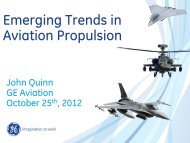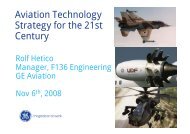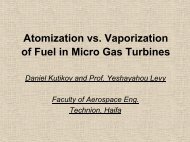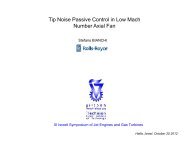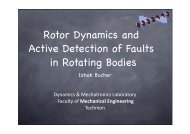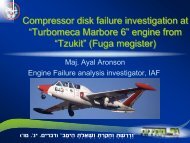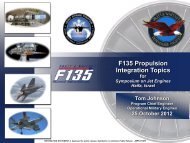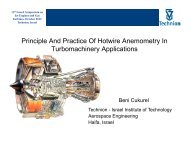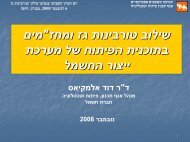Intelligent Incorporation Of Advanced Technology Into Legacy ...
Intelligent Incorporation Of Advanced Technology Into Legacy ...
Intelligent Incorporation Of Advanced Technology Into Legacy ...
You also want an ePaper? Increase the reach of your titles
YUMPU automatically turns print PDFs into web optimized ePapers that Google loves.
Four Steps For <strong>Intelligent</strong> <strong>Incorporation</strong> <strong>Of</strong> <strong>Technology</strong>1. Identify Stakeholders, Common Goals AndCritical Metrics– Example: USAF, P&W, Maintainers, Etc.Integrating The “Puzzle”OperationalLimitsStabilityMargin2. Review And Understand Engine Data– Performance, Safety, Affordability &Reliability3. Select Proven Technologies Ready ForInsertion <strong>Into</strong> A <strong>Legacy</strong> Engine4. Balance <strong>Technology</strong> Selections WithCustomer RequirementsGoal ManagementCustomizedControlActuatorManagementAutomaticControlDirectedMaintenance“Pieces of the Puzzle”3
Step 1: Identify Stakeholders & GoalsExample: USAF F100-PW-229• USAF Goals– Centralized Intermediate Repair– Reduced Maintenance Man-Hours– Increase Safety & Time On Wing;Reduce Maintenance Cost• P&W Goal– Improve The F100-PW-229 PositionFor The Future• USAF/P&W Common Goals– Focus On Safety & ReliabilityThrough 2035+4
Step 2: Review And Understand Engine DataExample: F100-PW-229Understand Fleet5
Step 3: Select Proven Technologies Ready For InsertionExample: P&W <strong>Technology</strong> Development & Engineering Standard WorkElementsP&W Engineering Standard WorkRigorous, Comprehensive and Continuously Improving<strong>Technology</strong> Review StepsEstablished Processes Used To Assess And Advance <strong>Technology</strong> MaturityAnd Facilitate Transition To P&W Engineering Standard Work6
Example: P&W <strong>Technology</strong> Pull Process• Technologies Are Selected Based On Proven Track Records– Commercial Engines Technologies» Output <strong>Of</strong> Development Engine Certification Process–5 th Generation Fighter Technologies» F119/F135 Development And Field Exposed Technologies• Technologies Must Meet Goals <strong>Of</strong> All Stakeholders To Be CostEffective7
P&W Example <strong>Of</strong> Technologies Evaluated For <strong>Incorporation</strong>• Turbine Airfoils– <strong>Advanced</strong> Cooling Configurations– Thermal Barrier Coatings– TMF / Oxidation Lifing Systems• Disks– Life Extension– Residual Stress Effects• Fan / Compressor Airfoils– Foreign Object Damage– Surface Treatments– Probabilistic Assessments– Erosion– Repair (IBR’s)– Mistuning (Field Effects)– HCF, Damping, etc.• Bearings– Monitoring / Trending– Hybrid Bearings• System– Usage-Based FleetManagement– Integrated Prognostics & HealthMonitoringTechnologies Selected Based On Best Fit With Desired Outcome8
Pull Process Guides <strong>Technology</strong> DevelopmentUSAFComponent Improvement ProgramActivitiesRobust Fixes For forCurrent IssuesEngine EnhancementPackageInterval ExtensionFocused Low Risk<strong>Technology</strong> InsertionUsage Based Lifing& Health Monitoring2012Turbine Technologies• Improved Coatings• <strong>Advanced</strong> Cooling SchemesFOD Tolerance <strong>Technology</strong>Logistics <strong>Technology</strong>Anomaly DetectionFault IsolationToday<strong>Advanced</strong> Life AnalysisFocused Wear TasksLLP Design Enhancements9
Example: F100-PW-229 EEP Prognostic Health MonitoringF100-PW-229 EEP Achieves Propulsion Safety, Affordability &Readiness Goals• Historical F100 IFSD CausesFrom Last 5 Years Evaluated• Early Identification <strong>Of</strong> AnomalyCan Avoid IFSD And CostlySecondary Damage• Directed Maintenance ActivitySignificantly Decreases Cost AndMistakes Leading To UnwantedConsequences10
Example: F100-PW-229 EEP <strong>Advanced</strong> LifingLeverages Science & <strong>Technology</strong> Investment In <strong>Advanced</strong> Lifing AndPrognosis• <strong>Advanced</strong> Rotor LifeTools Developed &Implemented For F100Usage Algorithm FeasibilityDemonstrated For F100Components Using ActualContinuous PW-229 Mission Data• Usage-Based LifingPotential Demonstrated& To Be Implemented InF10011
Step 4: Balancing <strong>Technology</strong> With Customer RequirementsFuture State <strong>Of</strong>EngineMaintenanceCustomer NeedsAlignmentW/GoalsEngine NeedsIFSDUER DriversAlignmentW/GoalsNewly DevelopedTechnologiesAlignmentW/GoalsImplementationAlign WithPlannedVisitsTiming of NextShop VisitAlignmentW/GoalsEngine CostPull Only Selected Technologies From Developed GroupingThat Best Meets Customer, Engine, Cost And ScheduleEffective AndAffordableSolutions12
Example: Effect <strong>Of</strong> F100-PW-229 EEP <strong>Technology</strong> InsertionIncorporated Technologies Reduce Maintenance Cost By 20%• 975 Engine Removals Can Be Avoided• Maintenance Cost Savings From Reduced UER And SER Removals$1,000CumulativeSavings ETOC(Millions Savings(Millions, FY07$)FY07$)$900$800$700$600$500$400$300EEP & Usage Based Life (UBL)$810$508EEP –ExtendedIntervalNetPresentValue(3.2%)$40$248$395$200$100$02005 2015 2025 2035$77EEP –CurrentIntervalEEP-CurrentIntervalEEP-ExtenedIntervalEEP-EMLI (UBL)13
Summary: F100-PW-229 EEP <strong>Technology</strong> InsertionF100-PW-229 <strong>Legacy</strong> Engine Safety, Affordability & ReadinessImprovedPW-229 Engine EnhancementPackage Objectives• Reduce IFSD Rate By 25%• Double Mean Time BetweenRemoval (MTBR)• Reduce UER Rate By Half• No Change In Depot Cost PerEngine• Incorporate In Depot BuildStandard By 2012Safety: Goal: 75% ReductionIn Propulsion RelatedClass A MishapsAffordability: Goal: 10% ReductionIn Propulsion RelatedMaterial / AcquisitionCostsReadiness: Goal: ATOWIncreased 2X14
SummaryP&W Is Committed To Product Performance, Safety, Affordability& Reliability<strong>Technology</strong> Pull Process Provides Cost Effective DevelopmentP&W Performs Extensive Testing To Mature Technologies &Selects Only Those With A Proven Track RecordF100-PW-229 EEP Provides Example <strong>Of</strong> <strong>Technology</strong> MaturationAnd Insertion To Meet Stakeholder Goals15



